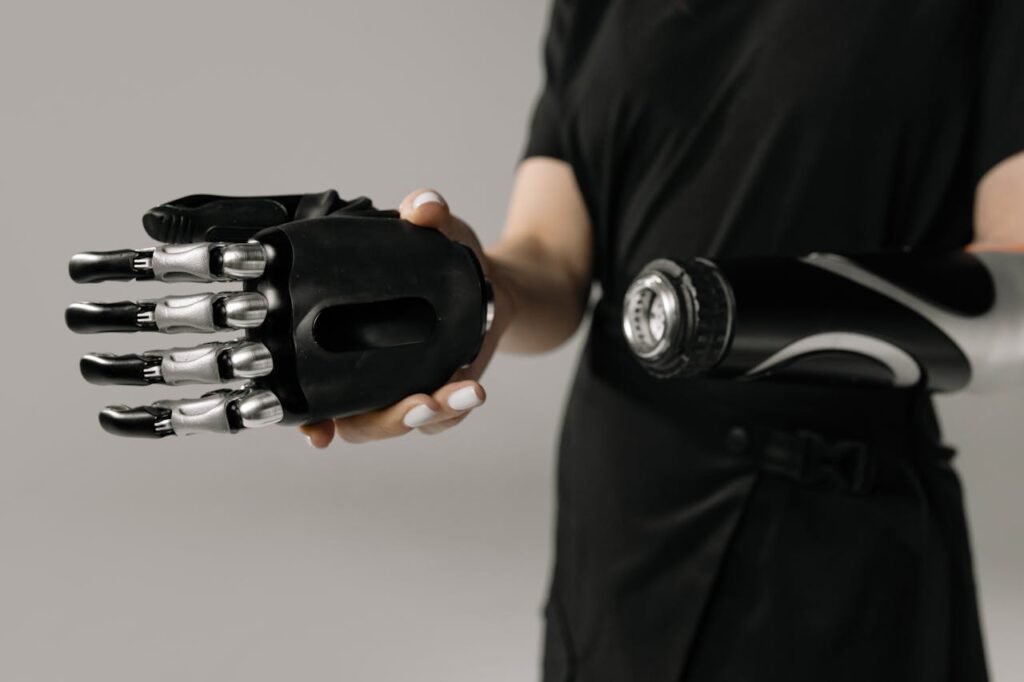There’s a quiet kind of magic that happens in a prosthetic trial room. It’s not about machines or wires or technology—it’s about people rediscovering something they thought they had lost forever.
In just one hour, lives can change. The first time a user closes a bionic hand with their own muscle signals. The first time someone picks up a cup or ties a knot again. The first time they feel, not just movement, but control.
At RoboBionics, we’ve seen these moments hundreds of times. Yet every single one feels new. Each story is personal, filled with courage, curiosity, and joy.
This article is a celebration of those moments—real people, real results, and real transformation—all within 60 minutes of their trial fit. You’ll see what happens inside that room, what users feel, and what they walk out with—not just in their hands, but in their hearts.
The First Ten Minutes: Anticipation and Discovery
The Emotional Beginning
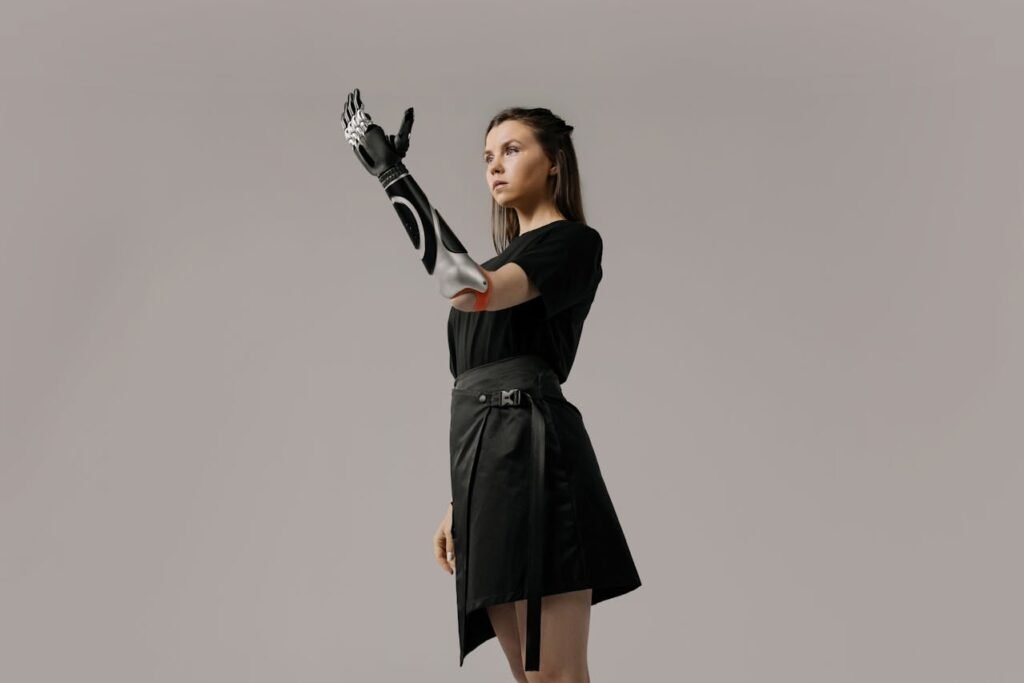
The first few minutes of any prosthetic trial are always charged with emotion. For most people, it’s a mix of excitement, nervousness, and hope. Some come in smiling, eager to try the technology they’ve heard so much about. Others arrive quiet, unsure of what to expect.
It’s an emotional moment because the idea of using a prosthesis—especially for the first time—can bring back memories of what was lost. But it also opens the door to what’s possible again. That’s why, at RoboBionics, we begin gently.
We talk. We listen. We help users feel at ease, because we know that before your muscles can connect with a prosthesis, your heart needs to feel ready too.
The Warm Welcome
Our trial rooms are designed to feel calm and welcoming, not clinical. The user meets their prosthetist, who explains how the session will unfold. There are no complicated words, no pressure to perform—just an easy, honest conversation.
We show the user the Grippy™ Bionic Hand or Mech Hand, explain how it works, and answer every question patiently. Holding the prosthesis for the first time is often a powerful experience. The weight, the texture, the design—it all feels real, tangible, within reach.
Those first few moments help break the tension. The user starts to imagine what life might look like with this new possibility.
Early Observations
Before we begin fitting, our team observes the user’s residual limb. We check healing, skin texture, and muscle response. Nothing invasive, just gentle assessments.
It’s important to understand each user’s anatomy, because every limb tells its own story. We measure and plan how to position the socket and sensors so that everything fits perfectly.
During this time, users often share their journey—what happened, how they’ve adapted, and what they hope to do again. These conversations remind us that this is not just a trial of technology, but a test of trust and human spirit.
The Next Fifteen Minutes: The First Fit
The Fitting Moment
When the socket goes on for the first time, silence usually fills the room. Everyone watches closely. The user feels the gentle pressure as the prosthesis secures into place. It’s a strange yet exciting sensation—neither painful nor heavy, just new.
The prosthetist ensures it’s snug but not tight. Then they attach the hand and begin the connection process, whether mechanical or myoelectric, depending on the model.
At this moment, most users say they start to realize this isn’t a demonstration—they’re actually part of something living and moving.
Adjusting to the Fit
As the prosthesis sits in place, the user begins to move their arm slightly, testing the balance. We make quick micro-adjustments if needed—raising, rotating, or loosening the socket until everything aligns naturally.
The goal isn’t perfection right away. It’s comfort. A relaxed body allows for better movement, and once the fit feels right, confidence begins to build.
Many users smile at this stage, saying, “It already feels like mine.” That’s the moment we know they’re ready for the next step.
Introducing the Controls
For bionic trials, we now connect the sensors. We explain that small muscle movements will send signals to the prosthetic hand, allowing it to open or close.
The user practices contracting and relaxing muscles. We adjust the sensor’s sensitivity until the signals register clearly. Within a few minutes, the screen lights up with their muscle readings—a visual confirmation that their body is communicating with the device.
When the prosthetic fingers move for the first time, it’s always a powerful moment. Some users gasp. Others laugh in disbelief. A few simply sit quietly, tears in their eyes.
Because in that moment, the connection between mind and motion is restored.
The Following Twenty Minutes: The Power of Practice
Learning to Move
Once control begins, we move into guided exercises. The prosthetist helps the user open and close the hand slowly, again and again, building rhythm and coordination.
The first few tries are often shaky. Movements can be jerky or delayed. But very quickly, the body begins to understand. The muscles learn, the signals strengthen, and the movements smooth out.
You can actually see confidence forming—shoulders relax, smiles appear, and hesitation fades. What began as effort turns into natural motion.
Holding Something Again
We introduce light objects next—a pen, a small ball, or a plastic cup. The user practices gripping and releasing. It’s simple, but deeply meaningful.
For many, this is the first time they’ve held something in years using both hands. The feeling is indescribable. The prosthesis doesn’t just respond—it cooperates.
The room fills with laughter as they realize how easy it feels. Each success builds trust between them and their new limb.
The First Real Challenge
Once basic control is mastered, we introduce slightly more complex tasks—like picking up a bottle or adjusting the grip on a textured object.
This helps the user understand how the Sense of Touch™ feature works in the Grippy™ Bionic Hand. The system automatically adjusts pressure so they can hold delicate or heavy items with equal ease.
The expression on their face says it all—astonishment mixed with gratitude. It’s the realization that life’s simple actions are possible again.
Conversations in the Room
During this stage, users often begin to talk more freely. They share memories, goals, even jokes. The trial space feels less like a lab and more like a friendly workshop.
Families watching nearby start recording videos, smiling proudly as their loved one performs movements they once thought impossible.
Every minute feels monumental. Sixty minutes suddenly seems too short.
The Last Fifteen Minutes: Reflection and Realization
Taking a Pause
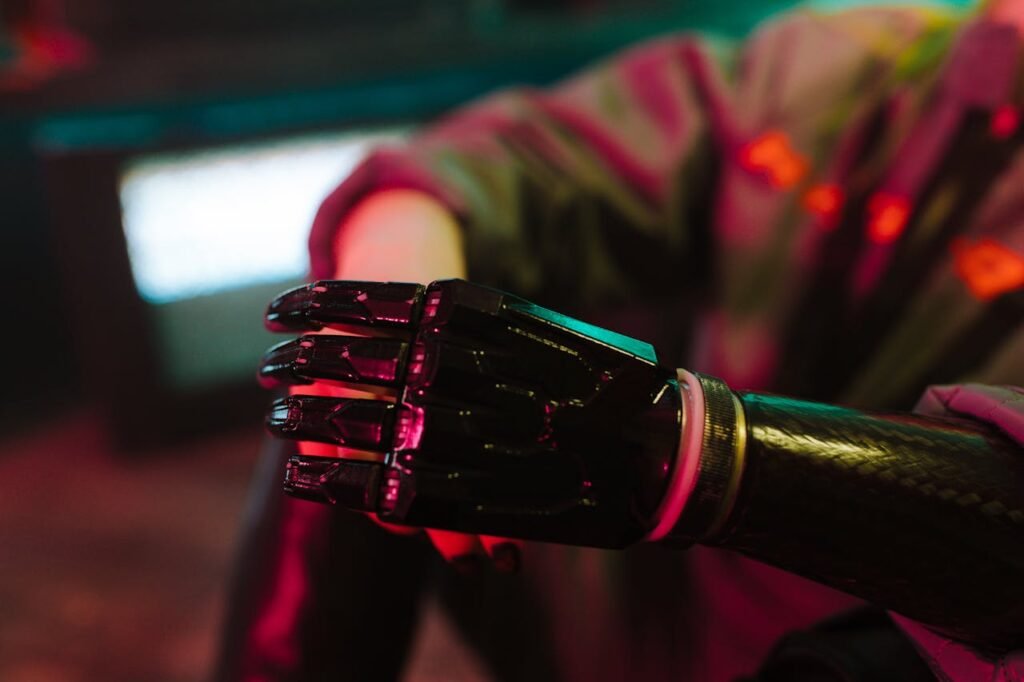
After intense focus and emotion, we take a short pause. The user removes the prosthesis, stretches their arm, and reflects. You can see the realization sink in—what they’ve just done, what they’ve just felt.
It’s a quiet, powerful few moments. Some users sit still, holding the device in their lap, as if to appreciate the journey between where they were and where they stand now.
Our prosthetist checks for any redness or discomfort on the limb. If adjustments are needed, they’re made immediately. The goal is to leave with both comfort and clarity.
The Feedback Discussion
We sit together to talk about the experience. Users describe what surprised them most—usually, how natural it felt. Many admit they expected it to be “more mechanical” but were shocked by how responsive and lifelike it was.
We explain how continued use, training, and physiotherapy will make the prosthesis feel even more seamless. This helps them understand that today’s progress is just the beginning.
The user often leaves this conversation lighter, calmer, and full of excitement for what’s next.
The Family’s Perspective
Family members usually share their own emotions—pride, relief, and amazement. They talk about how seeing their loved one use the hand gives them renewed hope.
Parents often get teary-eyed. Partners hold hands. Children clap.
It’s more than a technical demonstration—it’s a moment that redefines what’s possible for an entire family.
The Final Expression
Before leaving, we always ask one last question: “How do you feel?”
The answers vary, but they all share a common thread—freedom.
“Like I got a part of myself back.”
“Like I can do anything again.”
“Like I stopped being afraid.”
And that’s the magic of a 60-minute trial—it’s not just about trying a prosthesis. It’s about believing again.
Stories of Transformation: Real People, Real Results
Aarav’s Story: The Engineering Student
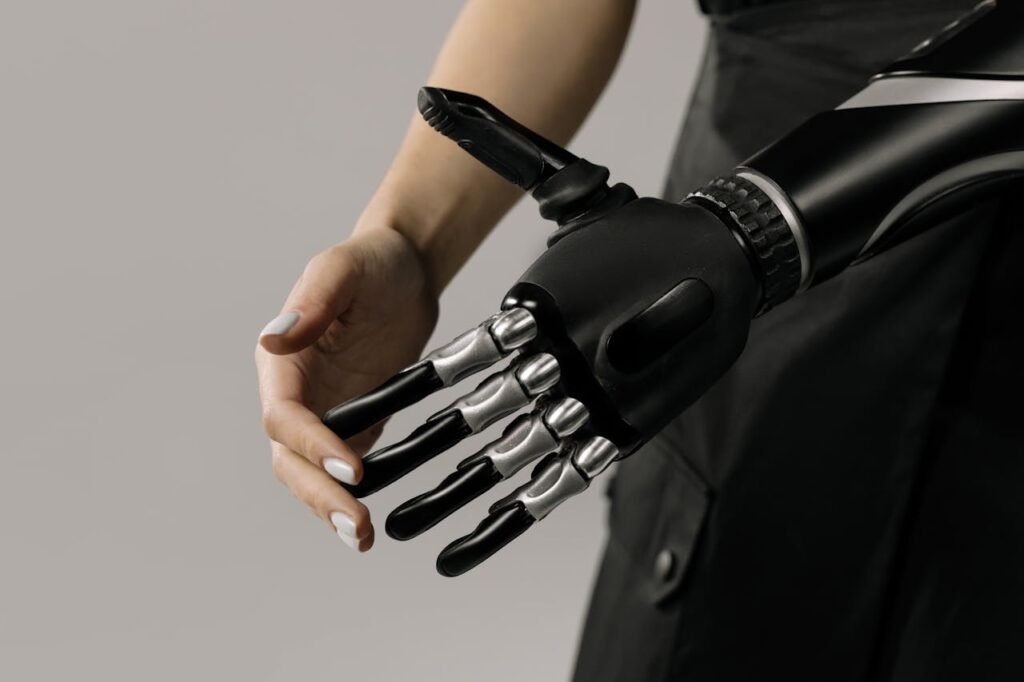
Aarav was a 22-year-old engineering student from Pune. He lost his right hand in a bike accident two years ago. When he walked into our trial center, he carried the same quiet determination that future engineers often do—he wanted to understand how things work.
He wasn’t afraid of technology. What he missed was precision — the ability to type, to write notes, to tinker with circuits the way he used to.
In the beginning, Aarav said, “I just want to see how responsive it really is. If it can keep up with me.” We smiled, because we knew it would.
Within minutes of fitting the Grippy™ Bionic Hand, Aarav’s curiosity turned to focus. He started testing every movement — gripping, rotating, releasing. His fingers twitched with concentration as he learned to control the hand through his muscle signals.
Then came the moment that changed everything: he picked up a pen and wrote his name again.
It wasn’t perfect, but it was his handwriting. He looked at the letters, paused, and whispered, “That’s mine.”
By the end of the session, Aarav was already asking about software upgrades, battery life, and customization options. His words were filled with excitement, not hesitation.
That 60-minute trial didn’t just reintroduce movement into his life — it rekindled his identity as an engineer.
Priya’s Story: The Homemaker
Priya was 35, a mother of two, from Lucknow. She had lost her left hand due to an infection following surgery. When she came for her demo, she held her son’s hand tightly, both nervous and hopeful.
Her goal wasn’t career-oriented or technical. It was deeply personal — she wanted to cook again, to feed her family the way she used to.
During the first part of the trial, she was shy. She smiled politely, followed instructions quietly, but didn’t speak much. When she first felt the prosthetic close in response to her muscle, she gasped softly. It was the sound of disbelief turning into wonder.
We gave her a soft sponge to pick up, then a lightweight cup. She hesitated at first but managed both beautifully. By the end of the hour, she was holding utensils, laughing nervously each time she succeeded.
Her little boy clapped, saying, “Mumma did it!”
Priya smiled through tears and said, “I didn’t think I’d feel this way again.”
For her, it wasn’t about mastering control or advanced technology. It was about reclaiming a piece of her daily life — and with it, her confidence as a mother.
Imran’s Story: The Workshop Owner
Imran ran a small mechanical workshop in Bhopal. He’d lost his right hand years ago in an industrial accident. He’d learned to manage his business with one hand, but the lack of grip strength made his work physically exhausting.
When he arrived for his Mech Hand trial, he was practical, not emotional. “If it works, it works,” he said matter-of-factly.
We fitted him with the Grippy Mech Hand — sturdy, lightweight, and designed for rugged use. As soon as he began testing it, his technician’s instincts took over. He adjusted the angle of movement, tested the grip tension, and immediately started planning how he could use it in his daily repairs.
Within half an hour, he was gripping small tools, holding bolts, and even tightening a screw. His precision shocked even him.
At the end of the session, he looked at the hand and said, “This doesn’t slow me down — it speeds me up.”
For someone who thought his working days were behind him, that one trial reopened a lifetime of possibilities.
Ananya’s Story: The Artist
Ananya was a painter from Kolkata. She lost her left arm at the forearm in a train accident. She had avoided trying prosthetics for years because she feared losing her artistic sensitivity.
When she finally visited our center, she said, “I’m not sure I’ll be able to feel anything.”
Her trial started slow. The first few minutes were all about regaining trust in movement. She tried picking up brushes, holding paper, adjusting pressure — all actions she hadn’t done since her accident.
Then came the surprise. The Sense of Touch™ technology in the Grippy™ Bionic Hand allowed her to feel resistance through subtle feedback. She could tell how tightly she was holding the brush.
Within an hour, she painted a small flower — her first piece in years. It wasn’t about perfection. It was about rediscovery.
She said softly, “I can feel again. Maybe not through skin, but through memory.”
Ananya’s trial reminded everyone in the room that art is not about hands — it’s about heart.
Rohit’s Story: The Young Professional
Rohit was 29, a marketing executive in Delhi. He lost his right hand in a car accident a year earlier. His biggest fear wasn’t losing work — it was losing confidence in public.
When he walked into our demo room, he dressed sharply but carried quiet anxiety. “I want to shake hands again,” he said, half-joking but fully sincere.
We fitted him with the Grippy™ Bionic Hand, explaining how muscle signals translate into movement. His first few attempts were stiff, but within minutes, he started smiling. The prosthesis responded naturally, reacting to his smallest flexes.
We handed him a business card to test grip. He held it perfectly steady, without crushing it. Then, he extended his arm and shook hands with his prosthetist.
He didn’t say much at first. But after a few seconds, he smiled and said, “That felt real.”
For Rohit, that handshake symbolized more than movement — it restored confidence. By the end of the session, he wasn’t looking at the prosthesis anymore. He was looking ahead.
Lakshmi’s Story: The Schoolteacher
Lakshmi taught at a government school in Chennai. She lost her left hand below the elbow in an accident involving public transport. Her greatest sadness was being unable to write on the blackboard or hold a piece of chalk.
When she arrived for her trial, she was calm but reserved. “I’ve learned to teach without it,” she said, “but I miss showing things to my students.”
We fitted her with the Grippy™ Bionic Hand and guided her through basic control. Within fifteen minutes, she was opening and closing her fingers confidently.
Then came the moment of truth — we handed her a chalk piece.
She hesitated, then slowly gripped it, lifted it, and wrote the word “hope” on a small whiteboard. Her handwriting trembled at first, then steadied.
Her eyes welled up, and she whispered, “That’s the first time I’ve written in two years.”
Her trial ended not with applause, but with quiet reverence. It was a simple act — writing a word — but it carried the weight of her identity as a teacher.
Vikas’s Story: The Farmer
Vikas was from a small village in Uttar Pradesh. He lost his right hand while working on a field thresher. For years, he depended on others for even small tasks like tying sacks or operating machinery.
He wasn’t familiar with technology, so he was hesitant when his local prosthetic center referred him to RoboBionics.
We started with a Mech Hand trial — durable and designed for heavy work. Within minutes, Vikas was gripping and releasing tools, his movements steady and strong. His eyes widened when he realized how much force he could generate.
We gave him a small rope to test his coordination. He managed to tie a simple knot on his own for the first time since his accident.
He turned to our team, smiling shyly, and said, “Now I can go back to my fields.”
For him, the prosthesis wasn’t about technology or appearance. It was about returning to the life he loved.
Sneha’s Story: The College Student
Sneha was a 19-year-old college student from Hyderabad. She lost her left hand as a child and had grown up using mechanical prostheses that were heavy and uncomfortable.
When she arrived for her Grippy™ Bionic Hand trial, she was excited but skeptical. She wanted to see if this hand could finally feel “light enough to live with.”
The moment we fitted it, she laughed. “It’s so light!” she said in disbelief.
She spent the next hour experimenting with gestures, even practicing typing on her phone. The Sense of Touch™ feedback helped her control grip strength perfectly. She could hold her phone securely without dropping it — something she had struggled with for years.
Before leaving, she recorded a video message for her friends: “It feels like my real hand. I didn’t think I’d ever say that.”
Her trial didn’t just give her movement — it gave her comfort, freedom, and self-assurance as she stepped into adulthood.
Beyond the Trial: How 60 Minutes Change Everything
The Ripple Effect of a Single Hour
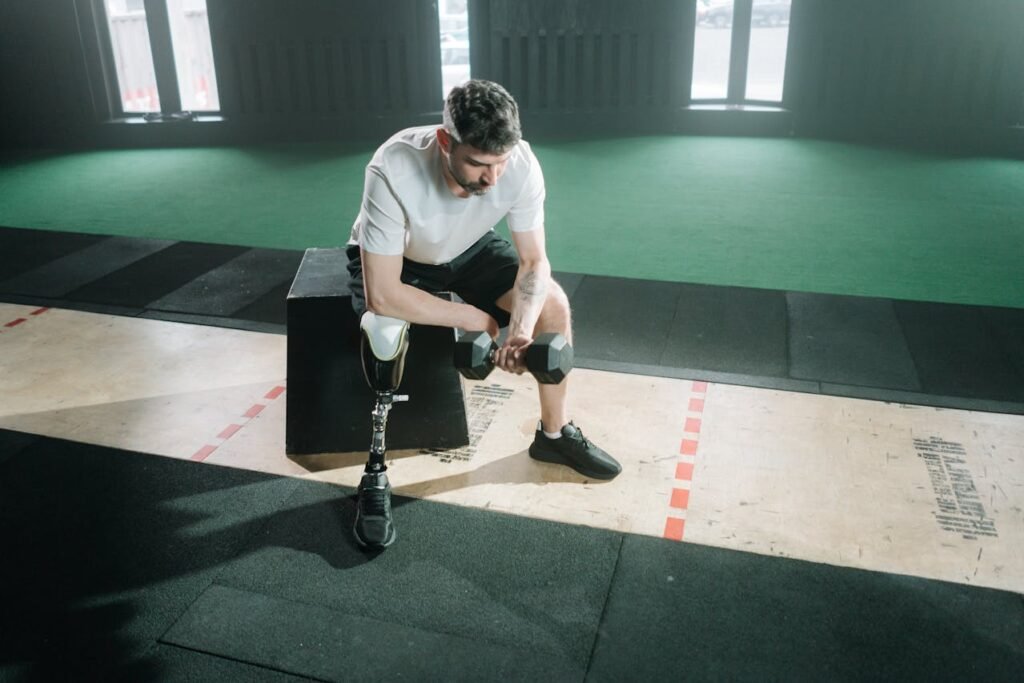
What happens in that one-hour trial doesn’t end when the prosthesis comes off. The real transformation begins afterward — in how users think, move, and carry themselves once they’ve seen what’s possible.
That single hour plants something powerful inside: belief. Belief that they can do things on their own again. Belief that life can feel normal, even joyful. Belief that technology doesn’t replace them — it restores them.
Many users leave our trial rooms not just smiling but standing taller, walking with new purpose. They’ve touched hope with their own hands.
Confidence in Motion
When Aarav from Pune first saw the fingers of his Grippy™ Bionic Hand respond to his muscle signals, he didn’t just rediscover movement — he rediscovered control. That moment of precision rewired his thinking.
In the weeks after his trial, he returned to college with more confidence. He started using his laptop, taking part in lab work again, and even presenting in class. His friends told us later that his energy had changed — from withdrawn to determined.
That’s the power of confidence in motion. It turns hesitation into momentum. And it starts with a single successful movement.
Reclaiming Roles and Routines
For Priya, the homemaker from Lucknow, her trial gave her more than function — it gave her identity back. Cooking for her family wasn’t just a task; it was a form of love.
After her demo, she told us she went home and spent the evening planning meals. Her husband said it was the first time in years she had looked excited about being in the kitchen again.
She didn’t even have the prosthesis yet, but that one hour had reignited her confidence. She could see herself doing what she loved again — on her own terms.
When a prosthetic trial goes right, it doesn’t just show users what they can do — it reminds them who they are.
Restoring Professional Dignity
Rohit, the marketing executive, said something unforgettable after his trial: “I don’t have to hide my hand anymore.”
Before coming to RoboBionics, he had avoided handshakes at work. He kept one hand in his pocket, hoping no one would notice. But that 60-minute session — that single handshake with our prosthetist — changed everything.
It wasn’t just a gesture; it was his return to self-assurance. He started meeting clients with renewed enthusiasm, and soon, he was sharing his story openly.
Moments like these remind us that a prosthesis doesn’t just restore function; it restores dignity.
Reconnecting with Purpose
For Lakshmi, the schoolteacher from Chennai, that one chalk mark on the board reopened her purpose.
In the days after her trial, she sent us a photo from her classroom — holding chalk, writing on a real board again. She said her students clapped when they saw her doing it.
“They said, ‘Ma’am, you’re back,’” she wrote in her message.
The pride in that sentence is something words can barely capture. It’s proof that technology, when made with care, can rebuild lives at the deepest level.
Physical Freedom, Emotional Healing
When users hold, move, and create again, something inside them shifts. The body regains rhythm, but more importantly, the mind regains peace.
We’ve seen users who walked in guarded and quiet leave laughing with their families. That laughter, that comfort — it’s the first sign of emotional healing.
For some, it’s the first time they’ve felt whole since their accident. For others, it’s the first time they’ve looked ahead without fear.
A successful trial doesn’t just fit the body — it frees the soul.
The Family Factor: Shared Hope
The Power of Presence
When we invite family members to watch a trial, we know it will be emotional. They’ve witnessed the user’s struggle firsthand — the frustration, the dependency, the pain of losing everyday freedom.
So when they see movement return, even in small ways, it’s overwhelming. Mothers cry quietly. Fathers smile proudly but can’t speak. Spouses exhale in relief.
Every small motion feels monumental because they’ve seen what it took to reach that point. It’s not just one person regaining movement — it’s an entire family reclaiming hope.
Encouragement That Keeps Momentum
Families play a huge role in what happens after the trial. Their encouragement keeps users practicing, adjusting, and progressing.
When Priya’s husband told her, “Let’s cook together tonight,” it wasn’t about the meal — it was about support.
When Lakshmi’s students clapped, it wasn’t about chalk — it was about pride.
Those small acts of encouragement turn a 60-minute experience into a lifelong journey of recovery.
Removing Fear from the Process
Some families walk into our centers with worry. They fear the prosthesis will be heavy, painful, or too technical to manage. But once they see the trial, those fears melt away.
They realize it’s not about complexity — it’s about simplicity done right. They see how intuitive the Grippy™ Bionic Hand or Mech Hand truly is, and that reassurance spreads peace throughout the family.
When families feel confident, users feel unstoppable.
The Technical Team Behind the Magic
The Human Touch of Engineering
Every trial is supported by our dedicated team of prosthetists, biomedical engineers, and therapists. But what makes them special isn’t just technical skill — it’s empathy.
They listen before they adjust. They observe before they explain. They understand that behind every fitting session is a story that deserves patience and respect.
We often say our engineers don’t just build prosthetic hands — they build trust, one adjustment at a time.
Precision in Every Move
During trials, our team focuses on micro details — alignment, electrode positioning, grip calibration. Each small correction ensures perfect responsiveness.
You might not notice the science behind it, but it’s there in every smooth motion.
When a user smiles after controlling their prosthesis for the first time, that smile is powered by hundreds of careful design choices — from the sensor’s placement to the socket’s contour.
Technology might move the hand, but human understanding makes it feel natural.
Learning from Every User
Every trial teaches us something new. Each limb, muscle, and story adds to our collective knowledge. We note every challenge, every success, and every emotion.
That’s how we keep improving our technology. Every Grippy™ Hand and Mech Hand today carries the lessons learned from real users who shared their journeys with us.
In that sense, every person who walks through our doors doesn’t just test our prosthetics — they help shape the future of prosthetic design in India.
The 60-Minute Milestone and Beyond
What Users Achieve in an Hour
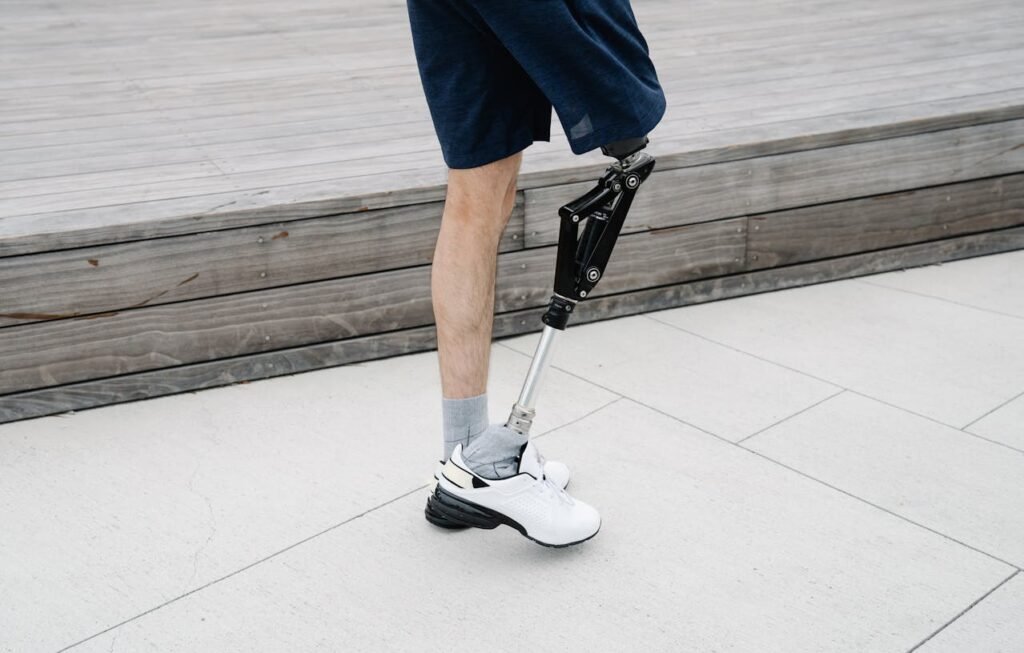
In just one hour, a person can go from uncertainty to control. From watching a machine move, to commanding it with their own body. From fear to freedom.
That’s what makes these sessions so powerful — they’re not demonstrations; they’re awakenings.
Within 60 minutes, users rediscover:
- How movement feels.
- How independence sounds.
- How confidence looks in the mirror.
Every trial session is a reminder that change doesn’t need years — sometimes, it takes just an hour of courage.
The Journey Afterward
After the trial, the next step is customization — creating a prosthesis designed specifically for the user’s limb, lifestyle, and comfort.
Our team explains every detail — pricing, timeline, training, and care. There are no surprises, no hidden costs, just clear, transparent guidance.
Most users schedule their fitting within days because they don’t want to wait to feel that freedom again.
Continued Support and Training
We stay in touch with every user long after their session. Through follow-ups, training programs, and remote assistance, we ensure the learning continues.
Users receive guidance on muscle exercises, maintenance, and real-world use. We also introduce them to our rehabilitation app — a fun, gamified way to strengthen control while tracking progress.
It’s not just about using a prosthesis. It’s about mastering it — comfortably, confidently, and joyfully.
Life After the Trial: When Hope Becomes Habit
The First Days After the Experience
The first few days after a prosthetic trial are often filled with reflection. Most users tell us they replay those 60 minutes in their minds—every movement, every emotion, every small success.
They notice changes in themselves, not just physically, but mentally. Where there was once hesitation, there’s curiosity. Where there was doubt, there’s determination. They start thinking in terms of when, not if.
Aarav went home and practiced muscle contractions in front of a mirror. Priya began holding small cups and utensils again with her natural hand, preparing herself for her full prosthetic fitting. Lakshmi wrote short notes daily to keep her hand muscles active.
Each of them was living in a new mindset—a mindset built in just one hour.
Everyday Confidence Returns
Confidence doesn’t arrive all at once. It grows quietly, one moment at a time. After a successful trial, users begin doing more without realizing it. They start walking more briskly, gesturing naturally, and smiling openly.
Their body language changes because they’ve experienced what control feels like again. Even before receiving their final prosthesis, they begin carrying themselves like people who can.
One of our users once said, “It’s strange—I don’t even have my hand yet, but I already feel like I do.” That feeling is what a good trial delivers: belief strong enough to move mountains.
From Dependency to Independence
The shift from depending on others to doing things yourself is profound. It’s not about pride—it’s about dignity.
Imran, the workshop owner, said it best: “For years, I asked others to help me tighten bolts or hold tools. After my trial, I realized I could stand in my workshop again without waiting for anyone.”
For homemakers, professionals, students, and laborers alike, this transition is life-changing. It gives back the one thing every human deserves—the right to act without asking for help.
When independence returns, everything else follows—confidence, motivation, and peace.
The Emotional Layer
The emotional transformation that follows a prosthetic trial often surprises users the most.
Many tell us they start sleeping better. They smile more. They talk about plans they’d stopped thinking about—travelling, working, drawing, cooking. It’s as if a quiet burden lifts.
We believe this emotional release happens because movement reconnects people with identity. When your body feels whole, your spirit follows.
This is why we always say that prosthetics are not just medical devices—they’re emotional tools for healing.
How Families See the Change
Everyday Reassurance
Families often notice the difference before users do. They see it in the way their loved one wakes up with purpose, the way they smile more freely, the way they speak about the future.
Parents tell us their children start laughing again. Spouses say their partners seem lighter, more relaxed. Even friends notice it—“You look happier,” they say.
When a prosthesis works, it heals more than one person. It heals the circle of people who love them.
Newfound Togetherness
Before the trial, families often try to help out of love but sometimes accidentally create dependency. After the trial, that balance shifts. Users start saying, “Let me do it.” And families let them.
This cooperation builds mutual pride and closeness. Parents feel proud watching their children master control. Children beam as their mothers cook again. Partners find new joy in everyday teamwork.
We’ve seen families walk out of our centers hand in hand—literally and emotionally—closer than when they arrived.
Stories That Inspire Others
Each family that goes through this journey becomes an ambassador of hope in their own community.
Imran brought two more workers from his village after his trial. Priya convinced another mother to try a demo. Lakshmi encouraged her students to believe that challenges can be overcome with patience and technology.
This ripple effect—the spreading of courage—is what drives us most at RoboBionics. One person’s victory becomes another’s reason to try.
Measuring Success the Human Way
What Success Really Means
For us, success isn’t just about performance metrics or perfect grip angles. It’s about what happens when a person looks at their hand and smiles.
We measure success in real-life moments:
When a student writes again.
When a parent cooks again.
When a worker earns again.
When a person dreams again.
Every small achievement adds up to a bigger transformation—the return of agency. That’s what defines our work.
User Feedback as Our North Star
After every trial, we ask users how they felt—honestly and openly. Their feedback guides everything we do.
If a socket felt slightly too firm, we adjust it. If a motion felt too quick, we refine the sensor. If something felt “almost perfect,” we don’t stop until it is perfect.
These small refinements have helped us create prostheses that aren’t just functional but personal.
The Grippy™ Bionic Hand, for example, evolved through hundreds of such insights—from lighter motors to smarter feedback systems—all born from real conversations with real people.
The Human-First Philosophy
At RoboBionics, we believe that technology must always serve humanity, not the other way around.
That’s why every trial is designed to be about comfort, clarity, and connection—not technical jargon. You won’t find pressure sales here. You’ll find people who care about your experience.
We’re proud to say that nearly every person who walks into our demo room walks out changed, whether or not they decide to buy immediately. Because they’ve seen what’s possible—and that vision stays with them.
The Continuing Journey: Beyond the First Hour
From Trial to Training
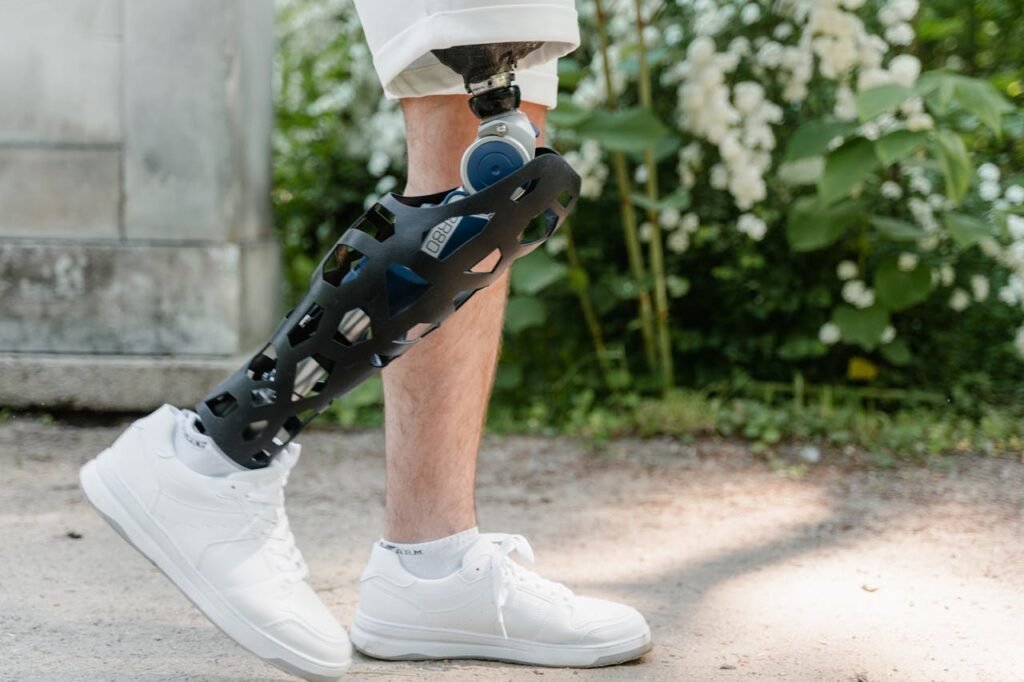
Once users decide to move forward, we guide them through training that builds muscle coordination and precision. We don’t rush this process—it’s about quality, not speed.
Through gentle practice, users learn to control each movement with less effort. Over time, it becomes instinctive.
We use our gamified rehabilitation app to make training enjoyable. It turns repetition into playful challenges, helping users strengthen muscle memory while having fun.
This approach ensures progress doesn’t feel like work—it feels like empowerment.
Adapting to Real-Life Challenges
We prepare users for real-world scenarios—buttoning shirts, driving, handling delicate objects, or lifting heavier items.
Our prostheses are tested in every kind of environment—from rural fields to busy cities—so users can rely on them wherever life takes them.
We also teach small self-check routines—like cleaning, battery care, and daily fit adjustments—to keep everything running smoothly.
The goal is always independence. Once you leave our center, you should feel confident doing everything on your own.
Building a Community of Champions
Over time, users from all across India have become part of what we call the RoboBionics family. They share tips, stories, and encouragement with new users starting their journeys.
We host meet-ups and virtual sessions where people connect, exchange experiences, and inspire each other. Seeing someone else succeed builds motivation that no manual or guide ever could.
Each story fuels the next. Each success multiplies.
A Future of Accessibility
We envision a future where advanced prosthetic technology is not a privilege but a right.
By manufacturing 60 out of 64 components locally, we’ve proven that India can create world-class solutions at a fraction of global costs. This allows us to reach more people, faster.
Affordability doesn’t mean compromise. It means inclusion. It means no one should ever have to choose between quality and access.
At RoboBionics, that future is not a dream—it’s already here.
The Spirit of Every Trial
What 60 Minutes Can Teach Us
In those 60 minutes, we see resilience. We see hope, courage, and humanity at its finest. We see people who once thought they’d lost everything rediscover their strength.
It’s easy to think of technology as cold or mechanical, but when you see someone move their fingers again—when they smile, laugh, or cry—it becomes something else entirely.
It becomes life.
Every user who walks through our doors teaches us the same lesson: progress doesn’t always roar; sometimes, it hums quietly in a room where someone picks up a cup for the first time in years.
The Hands That Build Hope
Behind every trial, there’s a team of hands building hope—the engineers, prosthetists, technicians, and therapists who believe in making movement possible for everyone.
They work tirelessly to refine each sensor, align every socket, and test every response. They do it because they’ve seen what even a small improvement can mean to a life.
Their reward isn’t just technical achievement—it’s the smile that follows.
Why It Matters
We believe in technology that respects the human story. A prosthesis should never feel like an object—it should feel like belonging.
Every time someone lifts, writes, waves, or hugs again, it’s a reminder that our work is about more than devices. It’s about dignity, choice, and freedom.
The world may see prosthetic innovation as a matter of mechanics. But we see it as a matter of heart.
Your Story Starts Here
How to Experience It Yourself
If you’ve ever wondered whether a prosthetic can truly feel natural, there’s only one way to find out—try it.
At RoboBionics, every trial is free, personalized, and pressure-free. You’ll have an hour that’s yours alone—guided by experts, surrounded by care.
You can book your session today at www.robobionics.in/bookdemo.
That single hour could change your life—just as it has for hundreds across India.
A Final Word
Every story you’ve read began the same way—with someone walking into our center, unsure of what to expect, and walking out with hope in their heart.
They didn’t just test a prosthesis. They discovered their own strength.
And if there’s one thing we’ve learned through all these trials, it’s this: people are far stronger than they think.
At RoboBionics, we’re just here to help that strength take shape—one hand, one movement, one story at a time.



